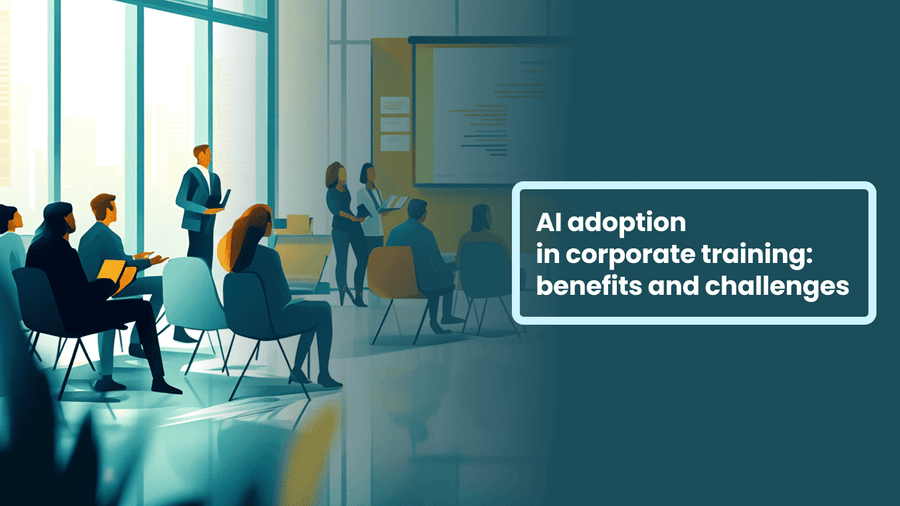Remember the days when corporate training meant sitting through hours of monotonous seminars, flipping through thick binders of manuals, or trying to stay awake in a rigid classroom setting?
Those days are fading fast. Over the past decade, technology has reshaped how we learn and grow in the workplace – and artificial intelligence (AI) is leading the charge.
AI has changed the way companies train their employees, making learning more adaptive, engaging, and accessible. While some worry that AI might replace human roles in learning and development, the truth is far more exciting.
Instead of replacing them, AI gives them better tools to design smarter, more impactful training programs. In this article, we’ll show exactly how AI transforms corporate training.
What the numbers say about AI adoption in corporate training
They say, “Seeing is believing,” but in business, believing often comes down to numbers. And here is what the numbers show.
A 2024 McKinsey report found that 72% of businesses use AI in at least one area of their operations. Large enterprises are even more invested: 42% already integrate AI into their workflows, while another 40% are actively exploring its potential.
Learning and Development (L&D) isn’t lagging behind. According to recent data, 60% of L&D teams are leveraging generative AI (genAI) for creating training content, supporting employee performance, or identifying skills gaps.
The benefits are real. For instance, the State of New Mexico, which is responsible for educating over 300 businesses in the state, cut content production costs by 70% and development time by 50% after adopting an AI-powered video tool.
We’ve seen similar results firsthand. One of our US-based clients implemented an AI-driven content generator for knowledge assessment and saw a 27% jump in conversion rates while slashing content creation time by 90%.
With such promising results, one might expect businesses to adopt AI in corporate training at full speed. But the reality is more complex. Let’s take a look at the challenges companies face when integrating AI into learning processes.
What’s holding businesses back from AI adoption
AI implementation comes with its own set of hurdles. Let’s break them down.
- Privacy & regulatory concerns
AI thrives on data, but not all data should be freely available. Companies worry about compliance with GDPR, CCPA, and other regulations. Training data often includes sensitive employee information, and ensuring it’s handled securely is a major concern.
Worried about keeping your AI-powered training secure?
Discover how to protect your data, ensure compliance, and build trust with our AI security whitepaper.
- Budget constraints
Investing in AI isn’t just about buying software – it’s about training staff, upgrading infrastructure, and ensuring smooth integration. For many companies, the upfront costs feel daunting, even if AI promises long-term savings.
- Lack of infrastructure & expertise
AI doesn’t work in isolation; it needs a well-built digital environment. Many organizations lack the necessary systems or in-house experts to implement AI efficiently. Without a solid foundation, even the best AI tools won’t deliver their full potential.
- Integration with existing systems
Corporate learning platforms weren’t originally designed to work with AI, which makes integration a challenge. Adding AI-powered tools often requires extra development work, making the process more complex than just “plug and play.”
- Fear of the unknown
Automation, machine learning, and AI can feel intimidating, especially for decision-makers who aren’t tech-savvy. Many companies hesitate simply because they don’t fully understand how to incorporate AI into their workflows.
- Measuring AI’s impact
How do you prove that AI-powered training actually works? Businesses struggle to set clear success metrics, such as how quickly new employees adapt, whether skills are improving, and if productivity increases after AI-assisted learning programs.
Do employees trust AI? Not always.
Employees, too, have their reservations. Many are hesitant to trust AI for skill assessments, career development, or automated course recommendations. The biggest issue? A lack of transparency.
People want to know how AI makes decisions – why it recommends one training over another, or how it evaluates skills. Without clear explanations, skepticism grows. Building trust means ensuring AI-powered learning tools are explainable, fair, and easy to understand.
The biggest roadblock is … leadership?
McKinsey’s latest research on AI in the workplace revealed something surprising. It’s not employees who are slowing AI adoption – it’s leadership. Workers are ready, but many executives aren’t moving fast enough to scale AI-driven solutions.
A Fishbowl survey from 2023 supports this: 68% of knowledge workers using AI didn’t tell their bosses. Since this research was conducted in 2023, AI technology has advanced even further. With newer versions of ChatGPT and the introduction of DeepSeek, the numbers are likely even higher today.
Dr Philippa Hardman, an AI & Education explorer and TED speaker, shared that according to her own research 70% of L&D teams were quietly using tools like ChatGPT, Claude, and Co-Pilot for tasks like writing emails, summarizing content, and generating activity ideas.
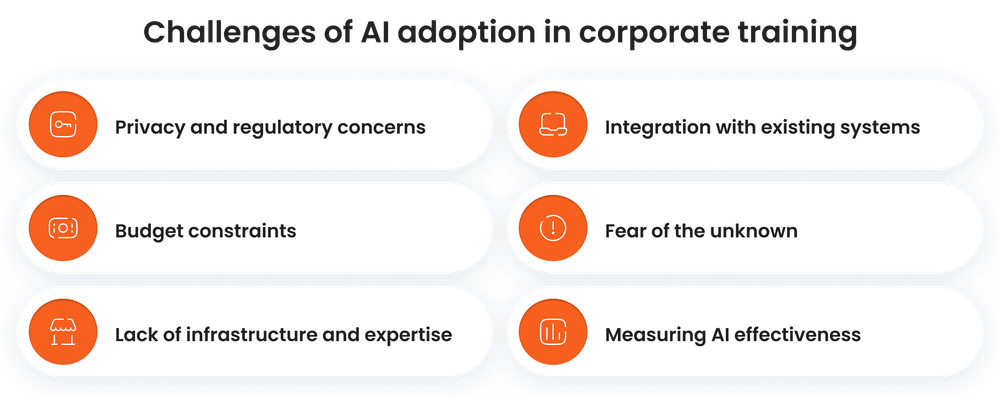
The pains of corporate training – and how AI fixes them
Corporate training isn’t just about teaching employees new skills – it’s about doing it effectively, efficiently, and at scale.
From our experience working with organizations across industries, we’ve seen firsthand the challenges they face in ensuring their training programs deliver real results:
- Managing high training costs – Developing, delivering, and updating training programs is expensive, especially for large organizations with diverse teams.
- Ensuring personalized learning – One-size-fits-all training doesn’t work, but tailoring content for every employee is time-consuming and costly.
- Tracking progress and measuring effectiveness – Companies struggle to see whether training actually improves skills and performance.
- Ensuring consistency across regions – Global businesses need standardized training while still accounting for language and cultural differences.
- Engaging a diverse workforce – Employees learn in different ways, and traditional methods often fail to keep them engaged.
- Aligning L&D strategies with business goals – Training programs should support company objectives, but many struggle to connect learning outcomes with real business impact.
- Retaining top talent – Employees expect career growth opportunities, but if training isn’t relevant or engaging, they may look elsewhere.
How AI contributes to the efficient corporate training
The good news? AI is stepping in to tackle these challenges head-on. The technology can be integrated in any cycle of corporate training.
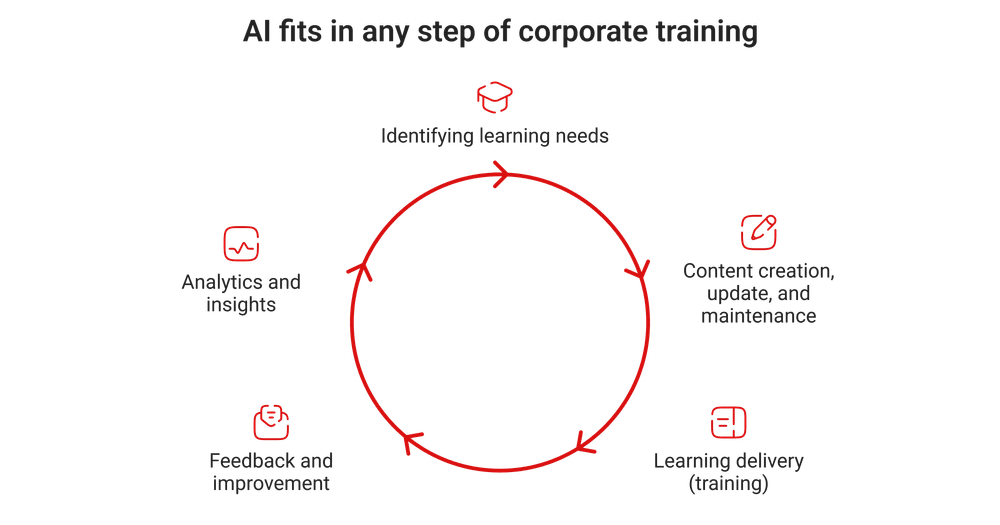
Below are some concrete AI use cases:
AI-powered content recommendations
AI analyzes employees’ roles, skills, and learning history to suggest the most relevant courses. By continuously adapting to user interactions, it ensures training remains aligned with individual career growth and company needs.
In tech companies, AI-driven platforms like Coursera for Business recommend coding tutorials or cybersecurity training based on an employee’s current skill set, ensuring targeted learning.
Learn how AI helps personalize content.
Adaptive learning paths
Rather than a rigid course structure, AI adjusts training in real time based on an employee’s progress. If a learner struggles with a concept, AI provides additional resources, while allowing faster progression through familiar topics.
Discover more about AI’s capability in personalizing learning experiences.
Chatbots for learner assistance
AI-powered chatbots provide instant support by answering questions, offering training guidance, and even delivering microlearning sessions. They enhance engagement by making learning more interactive and available 24/7.
We integrated an AI-driven chatbot into an educational platform to enhance student learning.
The solution automates inquiries, delivers personalized support, and ensures seamless integration with existing systems.

Skill assessments and gap analysis
AI-driven assessments identify knowledge gaps and measure proficiency levels. By analyzing test results and work performance data, AI helps organizations customize training programs to address specific weaknesses and skill development needs.
In healthcare, AI helps medical professionals identify areas where they need more training, such as surgical techniques or patient communication.
Content translation and localization
AI-powered tools automatically translate and adapt training content for different languages and cultural contexts. This ensures that employees across regions receive accurate and consistent learning materials without the need for manual translations.
AI also optimizes content for accessibility – simplifying complex terms for non-native speakers, adding alt-text for visuals, or adjusting formats for learners with disabilities. This ensures a truly inclusive training that works for everyone, everywhere.
We know how to make learning truly inclusive.
Explore how our AI tool helps learners with dyslexia focus better – boosting comprehension and reading flow while cutting content creation time by 70% and costs by 65%.
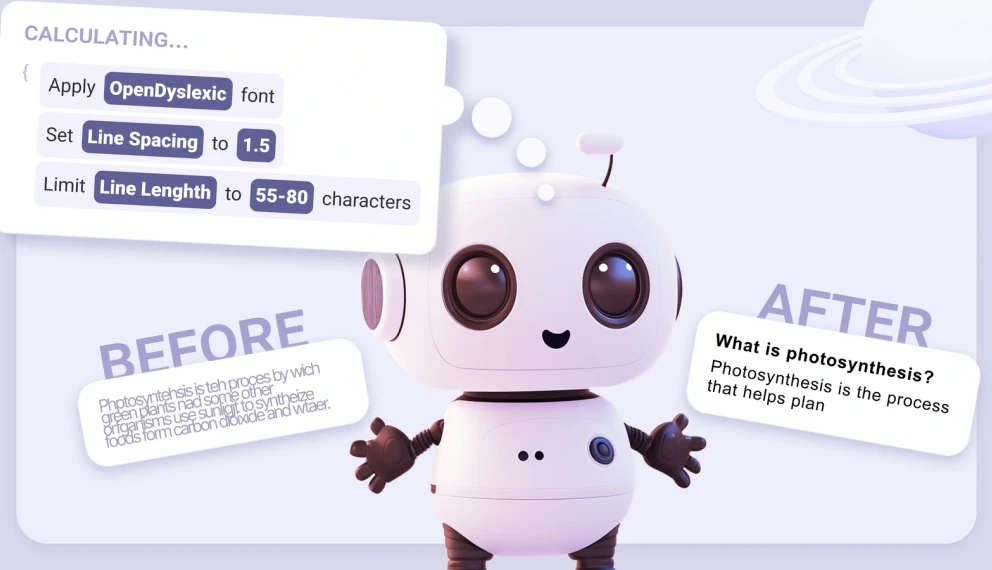
Predictive analytics for training needs
AI analyzes workforce trends, performance data, and learning behavior to predict future training needs. This allows organizations to proactively design learning programs that address skill gaps before they impact business performance.
Simulation and scenario-based learning
AI-driven simulations create realistic training environments where employees can practice skills in a risk-free setting. These interactive experiences boost retention by replicating real-world challenges, enhancing hands-on learning.
In aviation, for example, pilots train using AI-driven flight simulators, gaining hands-on experience before stepping into a real cockpit.
Compliance monitoring and automated reporting
AI tracks training completion, monitors regulatory compliance, and generates reports automatically. It helps organizations stay audit-ready by ensuring employees complete required training on time and maintaining a record of compliance.
Sentiment analysis for feedback
AI processes feedback from surveys, training interactions, and employee discussions to assess engagement and satisfaction. By detecting patterns in sentiment, it helps organizations refine training programs to improve effectiveness and learner experience.
For example, HR teams in corporate offices use AI to refine leadership training programs based on real-time employee sentiment.
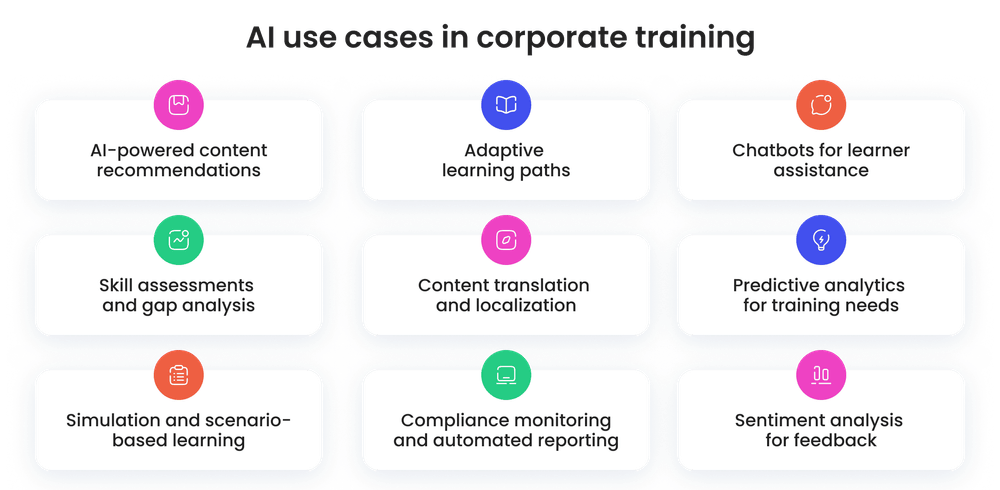
The future of AI in corporate training
While automation enhances efficiency, the most powerful outcomes emerge when AI and humans collaborate. Technology can optimize learning, analyze performance, and personalize training paths, but it still requires human expertise to guide, refine, and apply these insights effectively.
Some fear AI will replace jobs, but as NVIDIA CEO Jensen Huang puts it:
In training, this means that those who embrace AI will gain a competitive edge – improving skills faster, adapting to change more easily, and making more informed decisions.
AI doesn’t replace human intelligence – it amplifies it. The future of corporate learning isn’t about choosing between AI and people but about ensuring they work together. The best learning experiences will come from AI-driven efficiency paired with human creativity, empathy, and strategic thinking.
Organizations that understand this balance will not only enhance employee development but also build a workforce ready for the future.
How Aristek can help
If there’s a step in your corporate learning cycle that needs automation or improvement, AI fits right in – and we can make it work for you. At Aristek, we specialize in designing and creating AI solutions that address the unique challenges of corporate training.
Our expertise ensures that AI isn’t just a fanciness for your organization – it’s a practical, impactful tool that drives results. Book a free consultation now.
